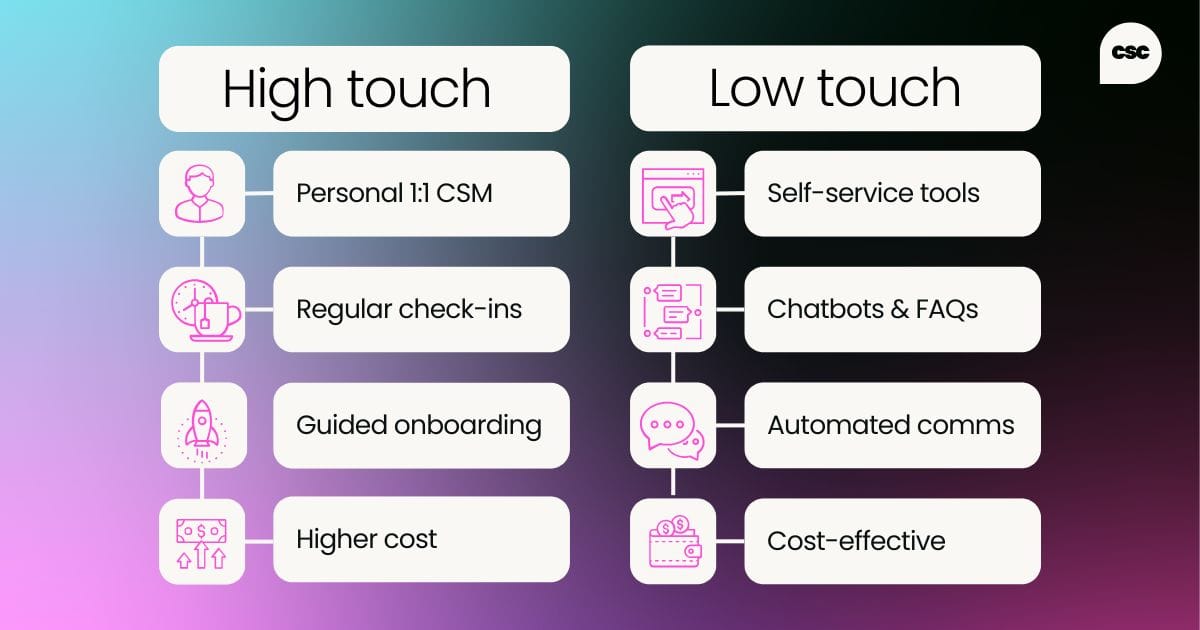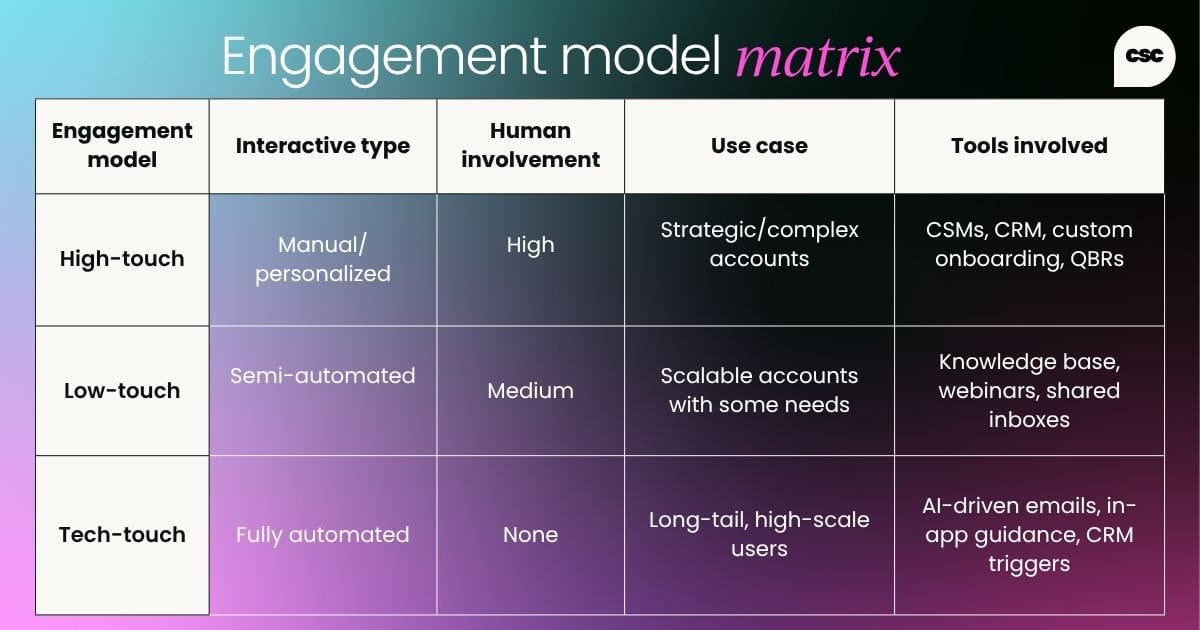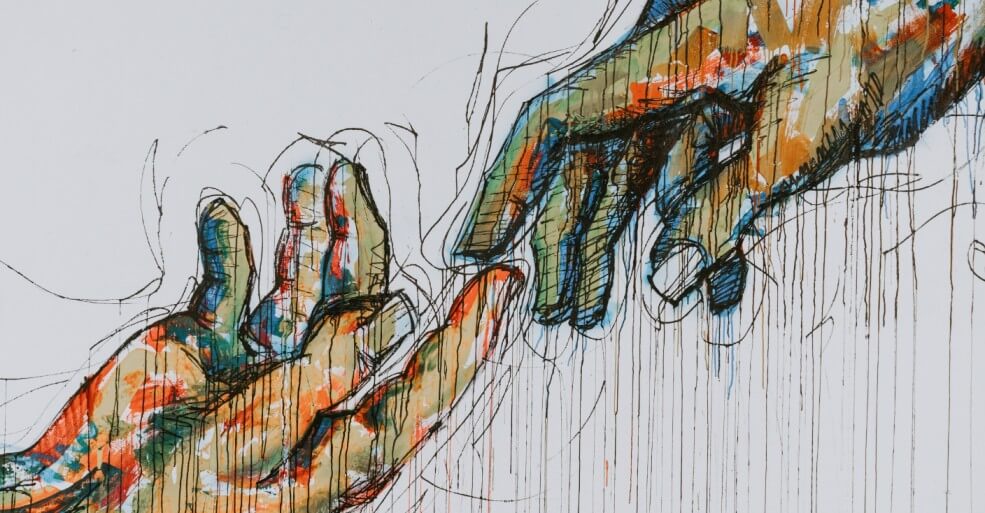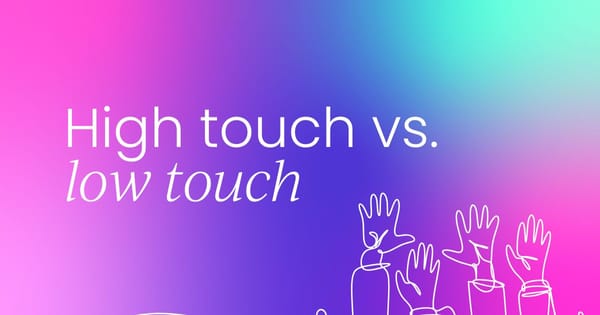Even the most accomplished salesperson will agree that you’re not out of the woods with the close of a sale. Anything can happen after conversion to cause a client to churn once they become a fully-fledged customer. That’s why customer success teams go above and beyond to engage with different customer types in the most appropriate way, balancing human interaction and automation to maintain retention.
Winning the deal is just the beginning. For long-term success, CS teams must align their engagement model – high-touch or low-touch – with each customer's goals, complexity, and value.
These are all forms of a broader customer engagement model that scales differently depending on the customer's value, needs, and goals.

Why this comparison matters
High-touch and low-touch aren’t binary – they exist on a spectrum. Your model depends on customer lifetime value, product complexity, resource availability, and the customer’s preferred experience.
Common questions we'll ask in this guide:
- What does high-touch mean in a business context?
- When should you use high-touch vs low-touch vs tech-touch?
- How does tech-touch scale customer success?
- What are examples of high-touch customer service?
- Is low-touch the same as no-touch?
- What makes an engagement model work in SaaS?
Quick definitions: High-touch, low-touch and tech-touch
- High-touch: Any model that prioritizes ongoing, human-led service or personalized relationship management across the customer lifecycle.
- Low-touch: A scalable model using automation, self-service, and limited human input.
- Tech-touch: A fully automated subset of low-touch, using data triggers, AI, and digital guidance.
- Touch model: Refers to the intensity of human interaction in customer engagement.
- Client engagement model: The framework your company uses to manage relationships with different customer types.
What are high-touch and low-touch engagement models – and when should you use them?
As a Customer Success Manager (CSM), figuring out the best way to interact with customers can be challenging. You don’t want to bombard them with onboarding emails or product updates, nor do you want to leave them in the lurch without human guidance.
Every customer has a different persona and expectation from your product. That’s why customer success engagement needs to flex.
- High-touch is all about hands-on interaction – dedicated CSMs, customized onboarding, regular check-ins, and strategic guidance.
- Low-touch relies on automation and content to guide users – think knowledge bases, onboarding videos, email sequences.
- Tech-touch goes even further, using AI and behavioral data to fully automate communication. It’s scalable and efficient, ideal for long-tail customer segments.

Not all low-touch strategies are tech-touch, but all tech-touch strategies are low-touch. The distinction matters when you’re scaling.
What is high-touch customer success?
Ordinarily, being a high-touch customer means having a 1:1 relationship with a dedicated Customer Success Manager. This expert becomes your guide, especially during onboarding and key growth moments.
In SaaS, a high-touch onboarding process could include white-glove implementation, personalized training, and frequent progress reviews, designed to reduce friction for complex setups.
"If a customer brings in $20M in recurring revenue, they get a dedicated CSM. 15 smaller accounts totalling $8M might share one. It’s about value, not volume."
– Santosh Sahoo, Global Head, Consumption at MuleSoft
From the point of sale, the CSM creates an implementation plan tailored to the customer’s goals. Success is defined by customer outcomes, not internal metrics.
High-touch is vital when:
- The product is complex or mission-critical
- The account is high-value (typically high ARR)
- Strategic growth or retention is a priority
But it’s also resource-intensive. It doesn’t scale well, and it’s costly if misaligned with account value.

Balancing those accounts with broader segments is where segmentation becomes critical.
What are low-touch and tech-touch customer success?
Adopting low-touch engagement with your clients doesn't mean you're neglecting them after the point of purchase. Instead, offering a more hands-off approach to communications means that customers are more self-sufficient and more reliant on automated features like in-app messaging and chatbots.
A big misconception about lower-touch customer success is that customers are abandoned from the word "go." Instead, there’s a greater reliance on tech to solve any issues they have.
In this model, users rely more on digital support:
- FAQs and help centers
- On-demand webinars or tutorials
- Automated lifecycle emails and in-app nudges
Some human oversight may remain, like a pooled CSM model, but efficiency is the goal.
Tech-touch takes it a step further: fully automated, behavior-triggered workflows that mimic 1:1 engagement without real-time human input. AI plays a big role in identifying when and how to intervene.
Despite being a B2C example, this model also applies to B2B SaaS and works best when:
- Product usage is intuitive
- Customer volume is high
- Personalization can be data-driven
That said, poorly implemented low-touch can lead to churn, especially if segmentation isn't done right.
How do I manage the transition from high-touch to low-touch clients?
If an account’s value drops or customer usage shrinks, it may make sense to switch from high-touch to low-touch. But transitions must be handled with transparency and empathy.
After his presentation at Customer Success Festival New York in March 2023, Santosh Sahoo, Global Head, Consumption at MuleSoft, was asked how expectations are managed, especially when they're used to a higher-touch service.
"Often, major adjustments, like a stark reduction in customer value (e.g., from a $3 million to a $1.5 million contract) preempt a change in engagement models. Every contract encapsulates explicit (written) and implicit (unwritten, expectation-based) components. Altering the former often necessitates a recalibration of the latter.
Why customer segmentation is everything
Proper segmentation is the backbone of scalable customer success. Without it, you risk over-delivering to low-value accounts or under-delivering to high-value ones.
Segmentation criteria can include:
- Annual recurring revenue (ARR)
- Product complexity or support dependency
- Account growth potential or strategic fit
Just because a customer pays more doesn’t mean they want weekly meetings. Some prefer autonomy. Segmentation helps you adapt to both behavior and value.
Engagement model matrix

Customer-to-CSM ratio
When it comes to figuring out the perfect CSM-to-customer ratio, you shouldn't purely look at the number of customers. Instead, you should look at the total annual recurring revenue those customers represent.
Santosh Sahoo, Global Head, Consumption at MuleSoft, says that:
"In the past, [MuleSoft] aimed for around $5 million in revenue per CSM. As our process has matured, we've found that CSMs can effectively oversee over $8 million in revenue."
So, the key factor we evaluate isn't strictly the number of customers, but the size and value of their business.
Understanding when to apply low-touch customer success
Just because a client is paying a lot of money for their subscription, it doesn't necessarily mean they need the full standard high-touch approach.
For some high-value accounts, weekly or biweekly one-to-one meetings might not suit their schedule. Sure, you want to check in regularly to make sure everything's ticking over nicely and they're still engaged. But if your POC in that company has low bandwidth, they won't want to be inundated with calls.
In this scenario, despite being a high-value, high-spending client, the standard cookie-cutter high-touch formula doesn't apply. Your high-touch client might prefer frequent calls and strategic support, or, conversely, just want autonomy and a check-in dashboard. It’s about tailoring touch to the account's preferences, not just spend.
If you'd like to learn more about the intricate ways you can segment your customer base, tune into the CS School podcast where we interviewed Kimberly Ayala, Director of Customer Success (North & South America) at Akeneo.
Can you create meaningful low-touch experiences?
Absolutely, but the key lies in smart customer segmentation and thoughtful use of technology.
There’s a common misconception that low-touch means impersonal or low-quality engagement. In reality, a well-executed low-touch (or tech-touch) model can feel highly personalized and impactful when it's powered by the right tools and data.
When using technology and data-driven insights, and personalized digital content, companies can scale their engagement while still making each interaction feel relevant. This allows businesses to provide the right level of support at the right moment, without relying on high-cost, one-to-one interactions.
Some proven strategies include:
- Behavior-based onboarding: Use product usage data to trigger personalized tutorials, tooltips, or emails.
- Interactive content: Embed videos or guided walkthroughs to address common friction points.
- Smart automation: Deliver the right message at the right time through lifecycle emails, in-app nudges, or chatbots.
- Centralized CRM systems: Ensure every customer interaction is informed by unified data, making even automated responses feel tailored.
Low-touch isn’t about doing less, it’s about doing smarter. When done right, it delivers scalable, cost-effective, and customer-centric experiences that build trust and drive retention.
To wrap up…
In all honestly, high-touch and low-touch engagement models all have to do with trial and error. Being open to change is a critical aspect of deciding whether you adopt a high-touch or low-touch engagement model.
If you’re just starting out, it might be an idea to start with a high-touch model initially so you can effectively learn the different customer personas and what type of communication they need from you.
Ultimately, we think customer segmentation is the winner. Using customer data (ethically) and learning their behaviors with your product is the most important factor in deciding which approach is:
- Financially suitable for you, and
- Gives the customer the appropriate experience with your company.
Still got burning questions?
Can I mix high-touch and low-touch models?
Absolutely. Many CS orgs now use hybrid models to combine automation with human support for key moments.
Is low-touch only for low-spend accounts?
No. Even high-value accounts might prefer autonomy. It’s about matching engagement to customer preference and lifecycle.
What if my customer segment changes over time?
Re-segment. Monitor product usage, ARR shifts, and engagement signals. Be ready to evolve your model accordingly.



 Follow us on LinkedIn
Follow us on LinkedIn






